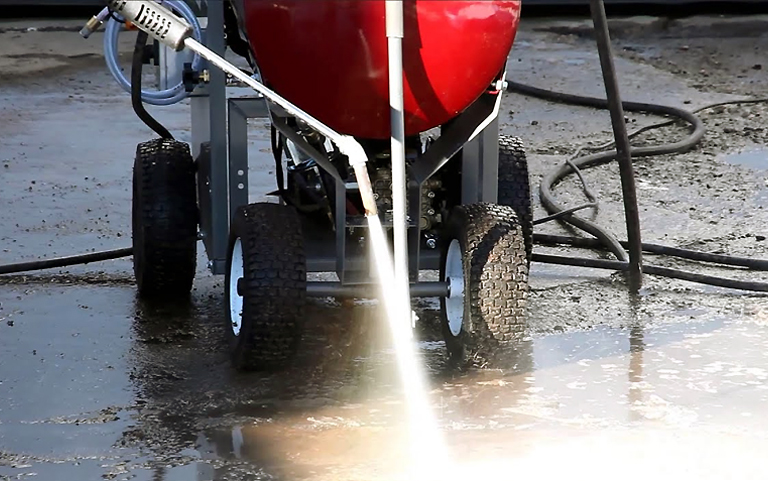Basics of Winterization
Posted by American Pressure on 1st Dec 2021
The idea is simple, in practice it becomes an art, a quick guide to the use of steamers at below freezing temperatures - Never stop the flow of water!
The Rules:
1.) Never stop the flow with water in your system. Water will freeze when it is colder than 32°F
2.) Always visually verify water flow out of the nozzle before turning on the burner/heat.
3.) Always have good antifreeze in the steamer before turning it off.
4.) In case of a problem, get the machine someplace warm as fast as possible, then figure it out.
Antifreeze:
There are a number of products that are used for antifreeze, ethylene glycol(typical automotive, green antifreeze), propylene glycol(Some RV, and Sierra), windshield washer fluid. We recommend ethylene glycol for the testability, function, and cost. Any chemical product should not be discharged on the ground, and care should be taken to prevent spills. Ethylene glycol or green antifreeze can generally be purchased at 100% strength, labeling will vary so make sure to read the fine print on the concentrate.
Some things to remember about ethylene glycol, antifreeze:
1.) 100% or straight antifreeze will Freeze at 10°F, so it is important to dilute it properly
2.) 70% antifreeze will give you the best protection at -60°F
3.) As you use it it will become more diluted and more will be needed
4.) Testers are available at most stores, purchase one and make use of it.
Procedure for starting up with a cold steamer, full of antifreeze:
As the temperature gets colder these procedures become more important. The below procedure demonstrates what you might expect to use as a best practice when temperatures are about 5-10°F Find your water source in the house, preferably a utility room or laundry tub, using an outside hookup is just asking for extra problems and will often not work properly in the winter. Connect your garden hose to cold water only (NEVER SUPPLY HOT WATER TO MACHINE).
Use a ball valve on the garden hose so you can turn the water on/off from outside. Turn on water and have your ball valve open slightly so a trickle of water comes through the garden hose and prevents it from freezing. Put this in a snowbank and let the water flow. This will keep your garden hose from freezing.
Find an electrical outlet that you can hook your steamer to, it will draw about 10 amps. The utility room is a great place to find an outlet; avoid circuits with many lights and appliances. Instruct your customer not to unplug your steamer or use a vacuum on the same circuit.
Warm up the machine before hooking up water:
The metal and antifreeze in the steamer will be the same temperature as the air. If you put water in the machine before warming it up it can flash freeze and cause many problems. To warm up the machine, put the wand in the float tank, turn on the pump. Once you observe the flow of antifreeze in this closed loop system, turn on the burner for 5 seconds, and then off for 15 seconds. Keep using 5 seconds of burner each 20 seconds of recirculating. After you do this for a few minutes you should notice the fluid is getting warm. When you notice the connections are warm to the touch it is time to introduce water. You do not want to preheat the machine to temperatures over 120°F.
Hookup water to your machine:
Your steamer is currently circulating antifreeze. Get your garden hose from the snow bank and if you have not had it on, make sure you turn it on for a minute to ensure it is not full of ice chunks and frozen material. Once you are sure you have liquid water flowing through your garden hose, hook it up to the Arctic Steamer. Direct the flow of antifreeze from the nozzle to a 5 gallon pail or other container, and turn on the water. In the course of about a minute and a half the water will push the antifreeze through the system, once the discharge turns from green to clear/white, direct it away from the antifreeze container so you do not needlessly dilute it.
– Tip – After you are pumping water, push down on the float valve to make sure the water supply can overflow the tank, if it can't it is only a matter of time before you run low on water, recirculate the water or winterize the machine and address the water supply problem. – Tip –
Using your Arctic Steamer:
Once you have water discharging from the nozzle, turn the unit to the burner. In the course of about 3 minutes you will go from cold water to a constant output of 280-290°F steam. At about 240-250°F you will see the discharge change in sound and appearance. It will go from sounding coarse to sounding smooth. In addition a steady drip of condensation will appear at the bottom of the steam spray. This drip will stay around until about 310°-325°F If you had accidentally hooked it to a hot water heater or the homeowner decided hot water would speed you up, you will visibly be able to see the spray is too hot from the change in the spray. Generally increasing over 290°F will not increase productivity and may damage hoses. Use the steam to remove pieces of ice, first by melting channels, and then between the roof and the ice. Let the steam do the work, do not force a piece of ice loose as a shingle may be damaged. Be mindful of the size of the pieces and what is below your work area. The closer you keep the nozzle to the ice the faster you will work.
Winterizing the Arctic Steamer:
After you are done removing ice, turn the switch from burner to pump. In about 3 minutes the water discharge will be cool. Turn off the water supply and let float tank drawdown, pour your antifreeze mixture into the float tank, and when it begins to come out green at the nozzle, direct the nozzle back into the float tank, allow the mixture to circulate for a few minutes. Use your antifreeze tester to make sure the mixture in your tank gives you proper protection. Turn off the machine. Circulating the mixture will serve to ensure the machine is fully and uniformly protected. Store your garden hose in the warm cab of your truck as it contains water.
Overview:
Warm the machine
Remove antifreeze
Verify Flow, Turn on Burner, and Work.
Cool Down Winterize
Turn Off
NEVER TURN OFF THE MACHINE WITH WATER IN IT.

